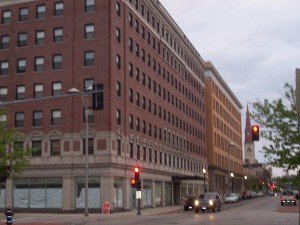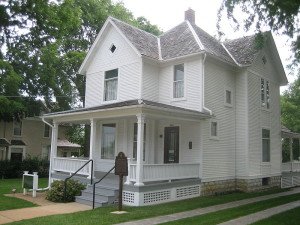This feature article is about the Illinois Lincoln Highway which extends across the state east to west for a length of 179 miles. Before we describe the Illinois section of this historic transcontinental highway, we want to offer you a brief history about this early 1900’s project along with some of the people who made it possible.
Thank you for reading this post, don't forget to subscribe! Roads Before the Lincoln Highway
Roads Before the Lincoln Highway
The Lincoln Highway was the nation’s first transcontinental highway.The highway, planned in 1913, had a positive lasting effect that fostered the Good Roads movement which also led to the establishment of the historic Route 66.
Prior to the conception of the Lincoln Highway, automobile manufacturers were growing by leaps and bounds but the highway situation in the country was something else altogether. In 1912 there were actually no decent roads (for automobile driving) in the U.S. There was no asphalt and concrete at that time and the definition of an improved road was simply one that was graded. There was also no general road plan. Roads would generally lead outside of a town in all directions.
Names Behind the Creation of the Lincoln Highway
Leaders were needed to galvanize action to make a coast to coast highway possible. Money would have to be raised and to accomplish this an adequate amount of promotion to the public was necessary. Help from the Detroit automakers and suppliers would be essential, most importantly from people like Henry Ford.
Most credit Carl Fisher with the original idea for this coast to coast national highway. Fisher is well known for several endeavors including the co-founding and building of the Indianapolis Motor Speedway at 16th Street and Georgetown Road, about six miles est of downtown Indianapolis, IN.

Fisher worked on a plan that in addition to building funds from automakers and auto suppliers, towns along the way would provide equipment and enjoy the commercial benefits of being located on this transcontinental highway. Another source of revenue would come from the public who for $5 each could be members of this historic highway.
As it turned out, Henry Ford refused to help fund the highway, believing that it as the public’s responsibility. Those however who joined Carl Fisher did include Henry Joy, the president of the Packard Motor Car Company and Frank Seiberling, president of Goodyear Tire Company.
Naming the Highway
At the time of the organizing and fund raising, there was no name chosen for the future highway. It just so happened that the federal government was mulling over spending $1.7 million for a marble monument in honor of Abraham Lincoln. Henry Joy from Packard came up with the idea for naming the highway after Lincoln and he and Carl Fisher then urged Congress to use the monument funds for the highway construction instead. The argument was that a transcontinental highway would make a much higher profile monument to the late President.
Routing the Highway
States were lobbying for routes that of course would be beneficial to them. As it turned out, the route chosen for the New York City to San Francisco federal highway would essentially be the most direct one. The Lincoln Highway has the distinction of being the first paved transcontinental highway in the nation.
The Illinois Lincoln Highway
Today, the Illinois Lincoln Highway is a 179 mile long National Scenic Byway. Travel this highway that runs through northern Illinois and discover each town and city’s unique culture and historic sites and landmarks.
The Lincoln Highway route enters Illinois on the east at the town of Lynwood and leaves the state on the west over the Mississippi River. The highway is comprised through Illinois via U.S. 30, and Illinois Routes 31 and 38.
The Illinois Lincoln Highway Coalition along with many local historians, artists and various civic leaders are all credited for the unique thirty-five interpretive murals along the Lincoln Highway. An excellent website with a detailed description of each mural is…http://www.drivelincolnhighway.com/murals/
You may also enjoy additional Trips Into History articles found on the links below…
Drive Wisconsin’s Picturesque Lake Superior Scenic Byway
Travel Michigan’s Copper Harbor Scenic Highway
Chicago’s Magnificent Mile / Historic Fourth Presbyterian Church

More attractions along the Illinois Lincoln Highway include Ronald Reagan’s Home and Visitor Center in Dixon, the 1950’s Midway Drive-In Theater in Sterling, Original 1928 Lincoln Highway concrete markers in Ashton, the 1926 Rialto Square Theater in Joliet, the Black Hawk Statue, the Eternal Indian in Oregon and many more.
Just as with the old Route 66 built years later, the Lincoln Highway spurred the opening of motor courts, diners and gas stations, drive-ins, roadside stands selling just about everything and of course hamburger stands. All things that served the motorist sprang up. Driving these historic highways today is truly taking a trip back into history as some of these old structures still exist today and several museums display photos of Illinois’ Lincoln Highway early years.
100 Year Anniversary in 2015
In commemoration of 100 years since the opening of the Lincoln Highway, the Lincoln Highway Association will host the “Henry B. Joy” Tour. The tour will run from June 27-July 8, 2015. The 2015 Tour will depart the Packard Proving Grounds north of Detroit, Michigan on Saturday, June 27 and take 12 days to travel 2,836 miles across America, arriving at the Lincoln Highway Western Terminus in San Francisco, California on Wednesday, July 8. For more information on joining this tour including rates and details, see website…..http://www.lincolnhighwayassoc.org/tour/2015/
Some very good books on the historic Lincoln Highway include…..Lincoln Highway Across Illinois, The Images of America by David A. Belden and Christine O’Brien…..Greetings from the Lincoln Highway: A Road Trip Celebration of America’s First Coast-to-Coast Highway by Brian Butko…...Lincoln Highway Companion: A Guide to America’s First Coast-to-Coast Road by Brian Butko.
(Article copyright Trips Into History. Photo of Reagan Boyhood Home courtesy of Ivo Shandor, CC By 2.5. Remaining photos and images in the public domain)

